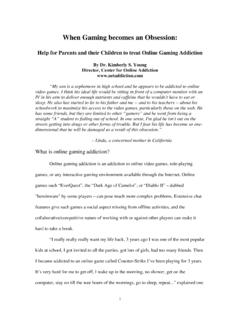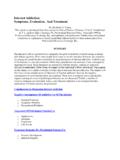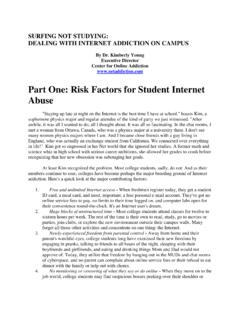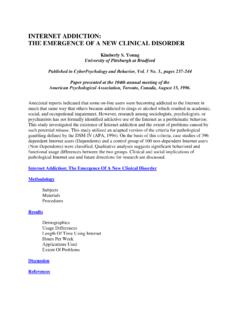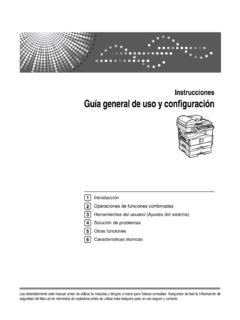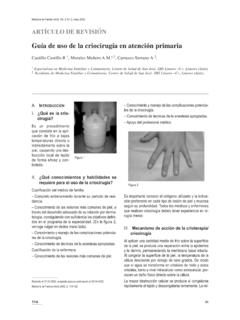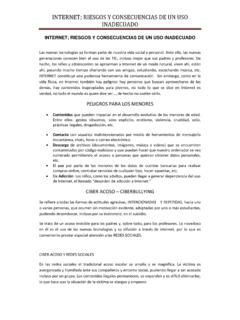Transcription of The Relationship Between Depression and Internet Addiction
1 The Relationship Between Depression and Internet Addiction by Kimberly S. Young and Robert C. Rodgers Paper published in CyberPsychology & Behavior, 1(1), 25-28, 1998 ABSTRACT Prior research has utilized the Zung Depression Inventory (ZDI) and found that moderate to severe rates of Depression coexist with pathological Internet Although the ZDI was utilized for its expediency with on-line administration, its limitations include poor normative data and less frequent clinical use. Therefore, this study utilized the Beck Depression Inventory (BDI), which has more accurate norms and frequent usage among dual diagnostic patient populations. An on-line survey administered on a World Wide Web site utilized the BDI as part of a larger study.
2 A total of 312 surveys was collected with 259 valid profiles from addicted users, which again supported significant levels of Depression to be associated with pathological Internet use. This article discusses how a treatment protocol should emphasis the primary psychiatric condition if related to a subsequent impulse control problem such as pathological Internet use. Effective management of psychiatric symptoms may indirectly correct pathological Internet use. Prior research has identified the existence of addictive Internet use, which has been associated with significant social, psychological, and occupational Addicts in this study used the Internet an average of 38 hr per week for nonacademic or non-employment purposes, which caused detrimental effects such as poor grade performance among students, discord among couples, and reduced work performance among employees.
3 This is compared to non-addicts who used the Internet an average of 8 hr per week with no significant consequences reported. Predominantly, the interactive capabilities of the Internet such as chat rooms or on-line games were seen to be the most addictive. This type of behavioral impulse control failure, which does not involve an intoxicant, was seen as most akin to pathological gambling. Therefore, a formal term utilized in this article is pathological Internet use (PIU) to refer to cases of addictive Internet use. Research in the addictions field has shown that psychiatric illnesses such as Depression are often associated with alcoholism3 and drug Further, research has shown that other addictive behaviors overlap with Depression -for example, eating disorders5'6 and pathological Although the concept of Internet Addiction has gained credibility among mental health professionals both in academic and clinical realms, little research has been conducted to examine if similar underlying psychiatric illnesses may contribute to such Internet Therefore, the objective of this study was to assess Depression and compare such results to other established dual diagnostic populations.
4 Young1 utilized the Zung Depression Inventory10 (ZDI), which suggested that increased levels of Depression are associated with moderate to severe levels of PIU. However, the ZDI yields limited clinical utility; therefore, this study used the Beck Depression Invento#1 (BDI) because it is a more psychometrically and clinically valid instrument to further investigate the effects of Depression on PIU. Finally, this study also attempted to increase its sample size from the previous examination (N -99) to improve generalizability of results. Method Subjects Materials Procedures Results Depression and Addiction Discussion References METHOD Subjects Subjects were self-selected active Internet users who responded to postings on electronic support groups and those who searched for the keywords Internet or Addiction on popular Web search engines ( , Yahoo).
5 Materials An on-line survey was constructed for this study. The survey exists as a World Wide Web (WWW) page (located at http: / edu/ ) implemented on a UNIX-based server that captures the answers into a text file. The on-line survey administered a structured diagnostic questionnaire that modified the DSM-IV criteria for pathological gambling'2 to classify subjects as addicted or non-addicted, followed by administration of the BDI, the Sixteen Personality Factor Inventory,15 and Zuckerman's Sensation Seeking Scale,13 as part of a larger study. Finally, demographic information was also gathered. Procedures The WWW location of the survey was submitted to several popular search engines available to assist on-line users in finding Web pages of interest.
6 On-line users entering keyword searches for Internet or Addiction would find the survey and have the option to follow the link to the survey in order to fill it out. Additionally, a brief description of the study along with the WWW address of the survey was advertised on prominent electronic support groups geared toward Internet Addiction ( , the Internet Addiction Support Group and the Web-aholics Support Group). Answers to the survey were sent in a text file directly to the principal investigator's electronic mailbox for analysis. Respondents who answered "yes" to five or more of the criteria were classified as addicted Internet users for inclusion in this study. RESULTS A total of 312 surveys were collected, resulting in 259 valid geographically dispersed profiles from addicted users.
7 The sample included 130 males with a mean age of 31 and 129 females with a mean age of 33. Educational background was as follows: 30% had a high school degree or less, 38% had an associate's or bachelor's degree, 10% had a master's degree or doctorate, and 22% were still in school. Of the subjects, 15% had no vocational background ( , homemaker or retired), 31% were students1 6% were blue-collar workers ( , factor worker or auto mechanic), 22% were non-tech white-collar workers ( , school teacher or bank teller), and 26% were high-tech white-collar workers ( , computer scientist or systems analyst). Occupational type appears to be a determinant in the level of Internet usage in this study. These results suggest that non-tech or high-tech white-collar workers are more likely to become addicted to the Internet than are blue-collar workers.
8 White-collar employment may offer wider access to the Internet and greater salary potential, making the purchase of a home computer more affordable compared to those in blue-collar types of employment, which may explain these results. Results from the BDI were a mean of (SD ), indicating mild to moderate levels of Depression compared to normative data. Prior research showed that analysis of the ZDI provided a mean of (SD = ), also indicating mild to moderate levels of Depression when compared to normal populations.~ Therefore, the BDI yielded similar results as the prior work suggesting that Depression is a significant factor in the development of PIU. Depression AND Addiction DISCUSSION As noted with other addictive disorders, our findings suggest that increased levels of Depression are associated with those who become addicted to the Internet .
9 This suggests that clinical Depression is significantly associated with increased levels of personal Internet use. These results should be interpreted with caution, however, as self-selected sample biases exist in this study coupled with the questionable accuracy of on-line responses. This study suggests that accurate assessment of Depression and PIU can improve early detection, especially when one is masked by primary symptoms of the other diagnosis. It is likely that low self-esteem, poor motivation, fear of rejection, and the need for approval associated with depressives contribute to increased Internet use, as prior research indicated that the interactive capabilities available on the Internet were found to be most It is plausible that depressives are drawn to electronic communication because of the anonymous cover granted to them by talking with others through fictitious handles, which helps them overcome real-life interpersonal difficulties.
10 Kiesler et found that computer-mediated communication weakens social influence by the absence of such nonverbal behavior as talking in the head set, speaking loudly, staring, touching, and gesturing. Therefore, the disappearance of facial expression, voice inflection, and eye contact makes electronic communication less threatening, thereby helping the depressive to overcome the initial awkwardness and intimidation in meeting and speaking with others. This anonymous two-way talk also helps depressives feel comfortable sharing ideas with others thanks to the personal control over the level of their communication, as they have time to plan, contemplate, and edit comments before sending an electronic message.
